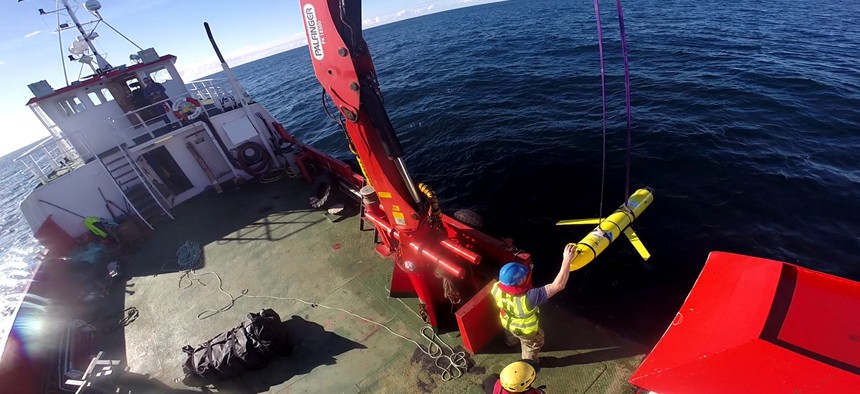Federal Spending on Drones Goes Under the Sea

Crew members aboard the VOS Raasay recover U.S. and British Royal Navy ocean gliders taking part in the Unmanned Warrior exercise off the northwest coast of Scotland, Oct. 8, 2016. U.S. Navy
Of the billions it spends on unmanned vehicles, the federal government's focus is shifting from the skies to the sea.
The government is still spending money on drones and research and development to improve them, but it's shifting its attention from the skies to the seas.
Federal agencies—both civilian and defense—spent about $31.3 billion on unmanned systems, the connected network of devices and sensors known as the internet of things, and cyber defense in the 2016 fiscal year, according to a report from research analytics firm Govini.
Research and development for unmanned ground vehicles and unmanned undersea vehicles rose 9.7 percent and 27.4 percent to $26.1 million and $138.8 million, respectively. Spending on technology to make ground vehicles interoperable rose 19.1 percent, and spending on unmanned undersea vehicles' platforms jumped about 13 percent.
» Get the best federal technology news and ideas delivered right to your inbox. Sign up here.
Overall, unmanned undersea vehicles saw the greatest growth across all drone segments; government investments jumped almost 20 percent to $605.4 million in fiscal 2016. Those drones are "increasingly important to DoD" but also have "civilian applications for deep sea and littoral exploration, surveillance and mapping," the report said. Those systems also are used to detect mines.
In contrast, spending on unmanned aerial vehicle platforms dropped about 4.3 percent to about $3.5 billion, while related research and development slipped 1 percent to about $203.2 million.
Broadly, agencies are beginning to invest in more than just the physical drones. They're purchasing processing, exploitation and dissemination capabilities to make the drones part of broader networks to gather information and relay it to decision-makers, the report said.
The report suggested agencies are also increasingly interested in artificial intelligence that can "be reprogrammed to instruct drones to do new things." For instance, commercial tech company Shield AI has contracts with the Defense and Homeland Security departments and its products can be trained to find people inside buildings without being controlled by a human, among other applications.
NEXT STORY: Federal Agencies Flirt with Blockchain





